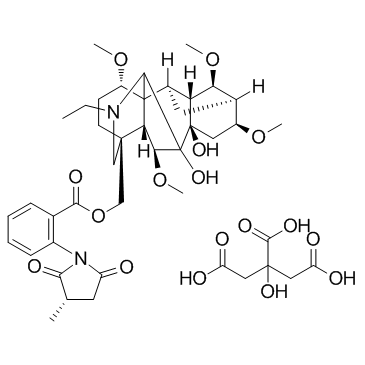Methyllycaconitine citrate

Methyllycaconitine citrate structure
|
Common Name | Methyllycaconitine citrate | ||
|---|---|---|---|---|
| CAS Number | 112825-05-5 | Molecular Weight | 874.92400 | |
| Density | N/A | Boiling Point | N/A | |
| Molecular Formula | C43H58N2O17 | Melting Point | N/A | |
| MSDS | USA | Flash Point | N/A | |
Use of Methyllycaconitine citrateMethyllycaconitine citrate is a specific antagonist of α7 neuronal nicotinic acetylcholine receptor (α7nAChR). |
| Name | methyllycaconitine citrate |
|---|---|
| Synonym | More Synonyms |
| Description | Methyllycaconitine citrate is a specific antagonist of α7 neuronal nicotinic acetylcholine receptor (α7nAChR). |
|---|---|
| Related Catalog | |
| Target |
α7nAChR[1] |
| In Vitro | Pretreatment with 5 and 10 µM Methyllycaconitine citrate (MLA) inhibits the decreased cell viability induced by Aβ25-35. Cell viability does not decrease after exposure to Methyllycaconitine citrate (2.5, 5, 10, 20 µM). Aβ25-35 treatment increases LC3-II levels, which is inhibited by administration of Methyllycaconitine citrate. Methyllycaconitine citrate also inhibits Aβ-induced autophagosome accumulation in SH-SY5Y cells. Flow cytometry also demonstrates decreased MDC-labeled vacuoles with Methyllycaconitine citrate treatment[1]. |
| In Vivo | Methyllycaconitine citrate (MLA) (6 mg/kg) given alone intraperitoneally does not cause climbing behavior when compare with the saline group. Pretreatment with Methyllycaconitine citrate significantly inhibits methamphetamine (METH)-induced climbing behavior, by about 50%. Methyllycaconitine citrate does not modify either basal locomotor activity or METH-induced hyperlocomotion. The METH-induced depletion of dopamine neuron terminals is attenuated in mice pretreated with Methyllycaconitine citrate (250±43 fmol/mg, n=7). A direct effect of Methyllycaconitine citrate on body temperature is ruled out because Methyllycaconitine citrate does not affect basal body temperature (37.0±0.5°C, n=5) or reduce the METH-induced hyperthermia (38.2±0.4°C, n=6, MLA+METH group, n.s. versus METH group)[1]. |
| Cell Assay | Cells are plated in 96-well plates containing complete medium and cultured for 24 h. Then cells are treated with Methyllycaconitine citrate at the indicated concentrations for specified times. After drug treatment, cell viability is measured by MTT assay. Briefly, 10 µL of the MTT solution (5 mg/mL) is added to each well and incubated for 4 h at 37°C. After removing the supernatant, 100 µL DMSO is added into each well. The absorbance is measured at 570 nm with a microplate reader. All experiments are repeated 3 times[1]. |
| Animal Admin | Adult male Swiss CD-1 mice are used in all experiments. They are housed at 22±1°C under a 12-h light/dark cycle with free access to food and drinking water. Climbing behavior is measured. Briefly, mice of 20 to 26 g are intraperitoneally administered saline (5 mL/kg) or Methyllycaconitine citrate (MLA) (6 mL/kg) at the beginning of the test. Twenty minutes later, the animals receive a single dose of saline or methamphetamine (METH) (1 mL/kg) subcutaneously and are placed individually, for habituation, into the experimental chamber consisting of a cylindrical cage with the wall made of plastic bars and covered with a lid. After a 20-min period of exploratory activity, stereotypy measurement is performed for a period of 30 min[2]. |
| References |
| Molecular Formula | C43H58N2O17 |
|---|---|
| Molecular Weight | 874.92400 |
| Exact Mass | 874.37400 |
| PSA | 276.43000 |
| LogP | 0.78950 |
| Personal Protective Equipment | Eyeshields;Gloves;type N95 (US);type P1 (EN143) respirator filter |
|---|---|
| RIDADR | NONH for all modes of transport |
| WGK Germany | 3 |
|
A potentially novel nicotinic receptor in Aplysia neuroendocrine cells.
J. Neurophysiol. 112(2) , 446-62, (2014) Nicotinic receptors form a diverse group of ligand-gated ionotropic receptors with roles in both synaptic transmission and the control of excitability. In the bag cell neurons of Aplysia, acetylcholin... |
|
|
Changes in Nicotinic Neurotransmission during Enteric Nervous System Development.
J. Neurosci. 35 , 7106-15, (2015) Acetylcholine-activating pentameric nicotinic receptors (nAChRs) are an essential mode of neurotransmission in the enteric nervous system (ENS). In this study, we examined the functional development o... |
|
|
TRIM29 regulates the assembly of DNA repair proteins into damaged chromatin.
Nat. Commun. 6 , 7299, (2015) Although DNA double-strand break (DSB) repair is mediated by numerous proteins accumulated at DSB sites, how DNA repair proteins are assembled into damaged chromatin has not been fully elucidated. Her... |
| Cyclosomatostatin |
| MLA |